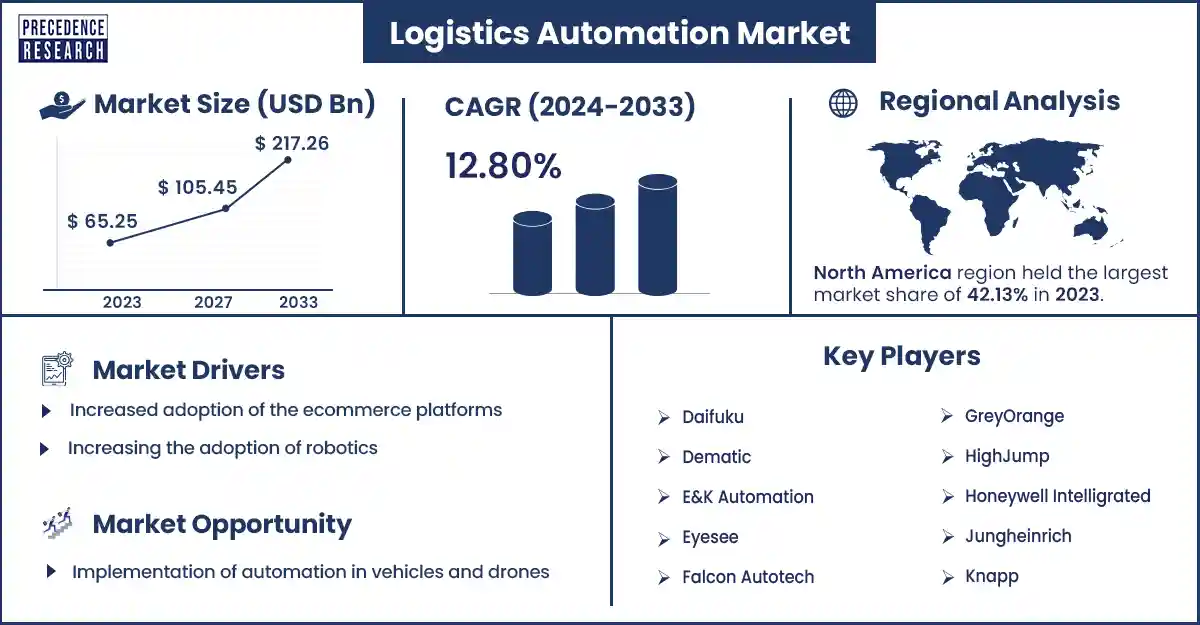December 2024
The global logistics automation market size was exhibited at USD 65.25 billion in 2023 and is anticipated to touch around USD 217.26 billion by 2033 expanding at a CAGR of 12.80% from 2024 to 2033. The market is growing due to the increased utilization of automated vehicles, mobile robots, robotic arms, and storage systems. Also, automation is adapting many companies and improving the service.

The logistics automation market deals with applying computer software or automated machinery to enhance the efficiency of logistics operations. Logistic automation is a game changer in the logistics industry. It implements automated technology in systems to optimize various things, including artificial intelligence, robotics, machine learning, and others. These technologies reduce manual labor and minimize errors. Due to several benefits, the market is growing, including enhanced efficiency, better management, increased accuracy, and improved customer satisfaction.
Automation technologies allow logistics companies to manage large volumes of goods more efficiently; automation is used in warehouse operations, inventory management, transportation of goods, and more, and automation logistics improve efficiency, productivity, and accuracy in these industries. Because of these benefits, the adoption of automation in logistics increased, which is growing the market.
Increasing the adoption of logistics robots can be a significant driver for the logistics automation market due to several advantages in e-commerce, which is a growing industry. As online shopping is increasing in the industry, consumers demand fast delivery, and same-day delivery is growing, and that increases the pressure on warehouses to manage the volume of orders. Companies like Amazon and Flipkart enhance and fasten their delivery service and adopt robotics. Robots are masters in packing, picking, and shipping products, reducing the processing times and human errors in these tasks. The adoption of robotics in warehouses also improves management because there is so much data, and it’s difficult to manage, but utilization of robotics can ease the workflow and manage the data. Robotics contribute to safety and risk prevention in warehouses; they handle physical tasks that can be dangerous for human workers and reduce the risk of injuries and accidents; these benefits increase the adoption of robotics.
However, the high investment cost can be a restraint for the logistics automation market. Implementing technologies such as robotics, artificial intelligence, and machine learning requires a high investment, and companies who want to improve their workflows have to invest a large amount, which can disturb their budget. This can reduce the adoption of these technologies and negatively impact the market growth.
| Report Coverage | Details |
| Market Revenue in 2023 | USD 65.25 Billion |
| Projected Forecast Revenue by 2033 | USD 217.26 Billion |
| Growth Rate from 2024 to 2033 | CAGR of 12.80% |
| Largest Market | North America |
| Base Year | 2023 |
| Forecast Period | 2024 to 2033 |
| Regions Covered | North America, Europe, Asia-Pacific, Latin America, and Middle East & Africa |
Recent Development by Jungheinrich
Recent Development by Falcon Autotech
Recent Development by Manhattan Associates
Asia Pacific is expected to grow at the fastest rate during the forecast period due to the increased adoption of automation in different industries, such as manufacturing and e-commerce for shipping, picking, and packing products. Many countries in the Asia Pacific face difficulties related to labor shortages and cost, and automation in warehouses reduces the problem and helps the market grow. In the Asia Pacific, governments also support companies in enhancing their workflow and improving their consumers' experience. Many companies in the Asia Pacific are using logistic automation, enhancing workflow, and growing the logistics automation market.
North America dominated the market in 2023 due to the early adoption of technologies in the different industries to improve consumers' experience. As the various sectors are growing and increasing, such as e-commerce and manufacturing, the demand for robotics and other technologies increases and makes work easy for companies in North America, and because of these things, the logistics automation market is logistics automation growing.
Implementation of automation in vehicles and drones
The adoption of automation in vehicles and drones presents a significant opportunity for the logistics automation market. Autonomous vehicles and drones are widely adopted, and they provide the potential to transform logistics operations, making them safer, more efficient, and environmentally friendly. Autonomous vehicles can handle tasks such as transportation, delivery, and even warehouse operations, reducing the need for humans and increasing operational speed and accuracy.
On the other hand, drones can be used for delivery, cameras to capture data inside the warehouse, and even package shorting in the warehouse; the development and deployment of these technologies in logistics are expected to optimize operations, reduce costs, and enhance customer satisfaction. Companies like Google and Tesla are leading the way in autonomous vehicle technology, while drone technology is rapidly evolving and offering new opportunities for logistics automation.
Market Segmentation
By Components
By Organization Size
By End User
By Type
By Mode of Freight Transport
By Application
Buy this Research Report@ https://www.precedenceresearch.com/checkout/2002
You can place an order or ask any questions, please feel free to contact at sales@precedenceresearch.com | +1 650 460 3308
December 2024
January 2025
January 2025
April 2025